Calculation of lift, pitching moment and form drag by the distribution of pressures on the model
The distribution of the pressures acting on the model is measured in a number of holes drilled normal to the surface. Measuring instruments are:
■ multitube manometer;
■ transducers each connected in succession to the holes of one or more pneumatic scanning valves (Scanivalve, see Chapter 1);
■ an electronic device scanning as many transducers as pressure taps.
Since the aerodynamic force is due to the difference between the pressure acting on the surface and the static pressure in the asymptotic stream, the tank of the multitube manometer or one of the chambers of each differential transducer is often put in communication with that pressure. The pressure coefficient
can be obtained then, in incompressible flow, dividing the readings of the differential multitube manometer by the reading of a differential pressure gage connected to a Pitot-static tube placed in the undisturbed stream.
Since the maximum pressure is the stagnation pressure, the maximum value of the pressure coefficient is Cp = 1 in an incompressible flow and slightly greater than 1 in a compressible flow. The negative pressure coefficient can reach the value Cp = -10
The distribution of pressure coefficients is given by a diagram in which is reported the coefficient normal to the surface (Figure 7.15) or to the main axis of the body, which, in the case of an airfoil, is the chord (Figure 7.16).
The force normal to the surface acting on an element of size 1*ds, is given by (Figure 7.15):
![]() dF = Cpqds
dF = Cpqds
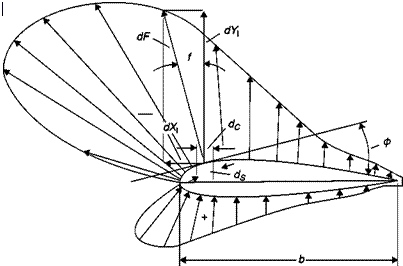 |
From Equation (7.2) the elemental forces acting normally and along the chord can be derived
dYt = Cpqds cos ф = Cpqdc dXj = CpqdsseпФ = Cpqdy
In integrating to the whole airfoil, it must be remembered that the force acting on the lower surface must be subtracted from the force dY in each element of the chord “dc”; similarly in the calculation of the force dX on the front in each section “dy” the corresponding force acting on the back of the airfoil must be subtracted. Thus the force Y in the section is calculated by Equation (7.4) where Cp = Cpi – Cpu
Y = qJCc (7.4)
It follows that when the distribution of pressure coefficients is that normal to the chord (Figure 7.16), the distance between the upper curve and lower curve represents the distribution of loading perpendicular to the chord. The integral (7.5) represents the enclosed area:
lCfdc=A(z) (7.5)
![]()
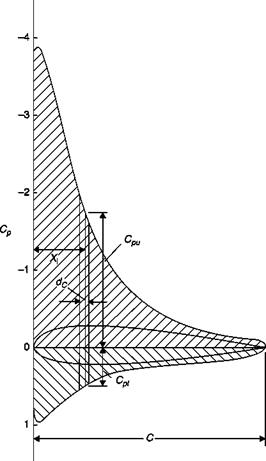 |
Distribution of the pressure coefficients on the chord of a lifting airfoil
If the wing is not twisted, the value of Equation (7.5) can be calculated in each section and a diagram like that of Figure 7.17 can be built and the total normal force, Yt, calculated as:
Y = qZnA(zdz (7.6)
where the integral is the area of the diagram of Figure 7.17.
The total force, Xt, in the direction of the chord is calculated in a similar way by the equation:
![]()
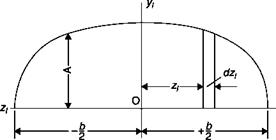 |
Distribution of normal force along the wing span
X = ff СрЯу = яЬ‘!ЬІ1 Z Cpdy (7.7)
where yu and yt are respectively the maximum distance of the upper and lower profile from the chord and Cp = (Cp)ant – (Cp)post.
The integral
VyCpdy = B (z) (7.8)
J yj P
is the area of the diagram Cp(y) of Figure 7.18. Bringing back to the diagram the values along the wingspan (Figure 7.19), the resultant force, Xt, can be derived from Equation (7.9) where the integral represents the area of the diagram of Figure 7.19:
X = qj h’lBd (7.9)

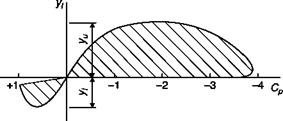 |
Distribution of pressure coefficients parallel to the chord of a lifting airfoil
![]()
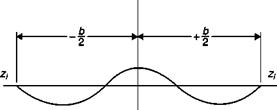 |
Distribution of the force parallel to the chord along the wing span
Also the aerodynamic moments acting on the wing can be obtained from the distribution of pressures, for example, the pitching moment with respect to the leading edge is given by:
Mz = q[Cpxdc (7.10)
Finally, the lift, L, and the form drag, of the wing can be obtained from:
L = Yt cos a – Xtsena
Df = Ysena + Xtcosa (7.11)
It must be stressed that, lacking a measure of tangential stresses, only the part of the drag due to the integral of pressures, that is the form drag, can be obtained from pressure measurements.














